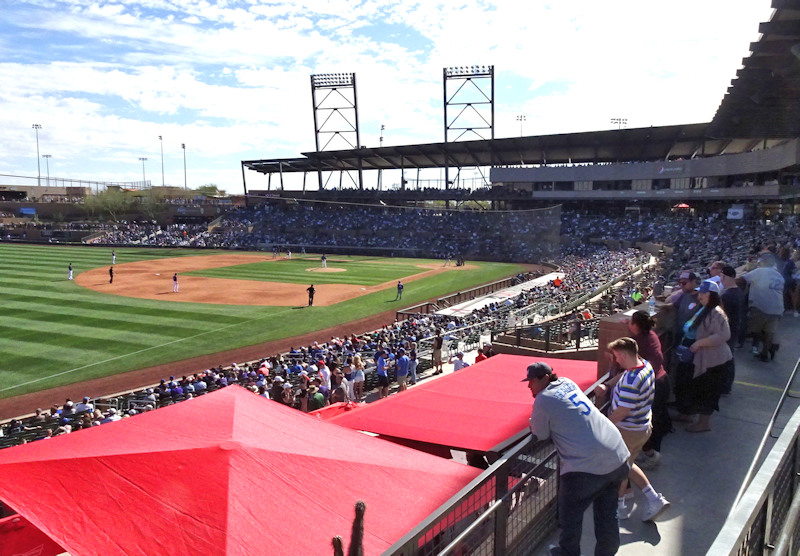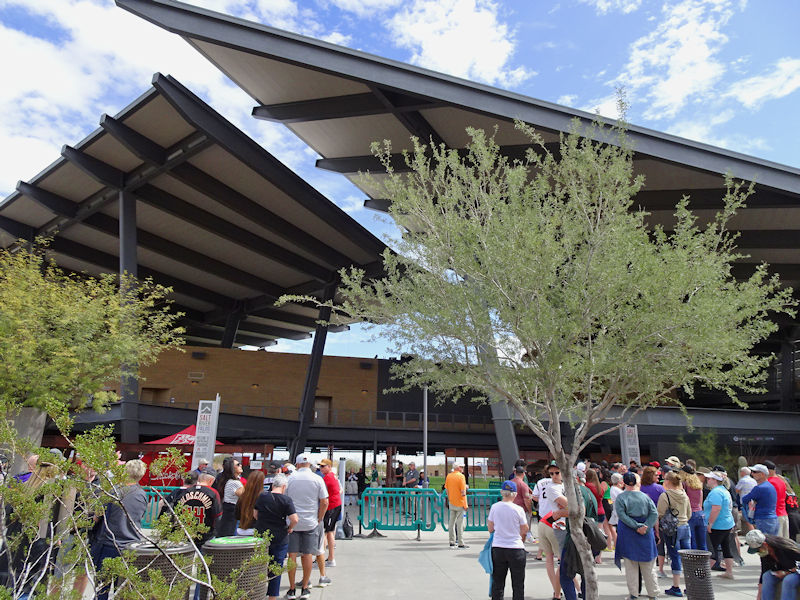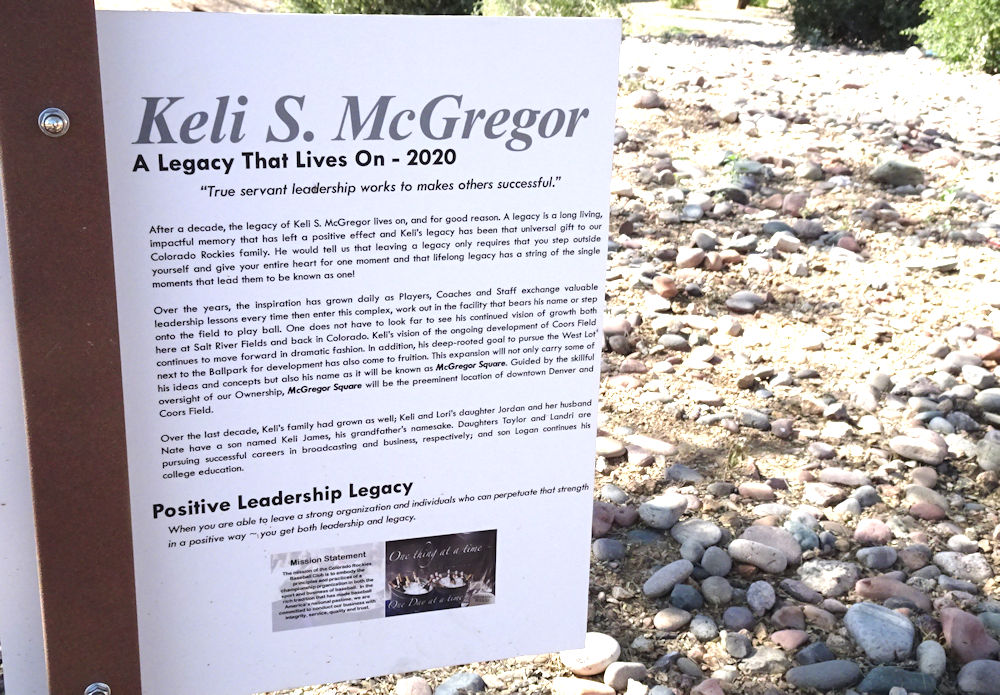
Text and photos by Joe Mock
This article first appeared in USA TODAY Sports Weekly’s Spring Training Preview on February 21, 2024. It is reproduced here by permission
SCOTTSDALE, Ariz. – In 2008, the Chicago White Sox announced they were moving their spring training operations from Tucson to a suburb of Phoenix the following year. That left only the Colorado Rockies and Arizona Diamondbacks with spring operations in Tucson.
This scenario put the Rockies and D-backs in a bind. To play exhibition games, they would only be able to compete against each other or suffer through a four-hour roundtrip bus ride to Phoenix to face off against the other Cactus League teams.
Keli McGregor was the president of the Rockies at the time. “When Keli began thinking about leaving Tucson, he asked me if there’s any way to do it,” recalls Diamondbacks president Derrick Hall. “I said let’s do it together.”
So the two began a search for an acceptable site for a two-team complex in the Phoenix metro area. Hall notes that there were plenty of options, but one near Scottsdale clearly stood out.
“I will never forget when Keli and I pulled up to the old golf course. We looked out and we both said, ‘This is it! Just look at those views.’ We both got chills. We went back to our respective owners and told them that we’ve got the spot.”
But there was still due diligence to perform and formal analysis to be made. Plus someone needed to pay to construct such a facility.
Not only was that golf course due to close soon, it was on land that is part of the Salt River Pima Maricopa Indian Reservation. In early 2009, the tribal community there was one of six local entities invited to submit a proposal to build the new spring training complex within its jurisdiction.
Needless to say, the proposal from the Native American community was the winner. The complex now known as Salt River Fields at Talking Stick was built on the old golf course, with the first exhibition game occurring February 26, 2011.
Today, the complex is generally regarded as the best of Major League Baseball’s 23 spring training sites … but there is much more to the story of the tribal community’s role in creating this top-notch facility.
River People
For centuries, the Pima Indian tribe lived peacefully next to its closest neighbors, the Maricopa. Not only did they trade with each other, they also protected the other from invading tribes, typically the Apaches.
Not long after this land was claimed as a U.S. Territory in 1848, the Federal Government decreed that these two tribes be combined into one for purposes of establishing a tribal constitution and reservation boundaries. The government also gave the communities no say-so in the name assigned to the combined tribe.
“Ironically, the terms Pima and Maricopa aren’t native words. Those are the white man’s words,” explains Bryan Meyers, the tribe’s community manager. The Pima are actually the “Akimel O’Odham” in their language, which translates to River People. The correct name for the Maricopa is “Xalychidom Piipaash,” which means People Who Live Toward the Water.
Changing the tribes’ names was just the first in a long line of indignities imposed on the people who occupied these lands long before white faces arrived. Among the most egregious injustices was the diverting of water from the Salt and Gila Rivers away from Pima farmers to provide irrigation for white settlers.
This reservation, which is situated east of Scottsdale and north of Mesa, is governed in a similar fashion to a U.S. city. There is an elected president, vice president and seven council members. It’s this tribal council that was invited to respond to the Request For Proposal from the Rockies and D-backs.
Given the mistreatment of the Native American population over the past century and a half, it’s easy to understand why the tribal council was hesitant about responding to the RFP regarding a baseball complex. “I think tribes have been taken advantage of in many instances, to say the least,” notes Meyers. “There is a general mistrust, and that was a big hurdle for us to deal with.”
“Whenever we are looking at a new venture, we like to ask other tribal communities what their experiences have been, to get the do’s and don’ts,” explains Martin Harvier, the president of the community. “With this, there were no other examples of stadiums being built on tribal land.”
With no playbook to follow plus the massive amount of money the council was being asked to pay to build the complex, “There were a lot of naysayers,” recalls Meyers. “Our people and some of our lobbyists said this is crazy (and) a horrible idea.
“It was a scary proposition.”
Making matters worse, the U.S. economy was in a significant downturn. The flagging economy had badly hurt the commercial ventures on reservation land, including the golf course and a sprawling shopping center next door that had an alarming number of empty storefronts.
“The community had some very deep discussions about if we even wanted to respond” to the RFP, recalls Harvier. “I think we all wanted to, but financially was it the right thing to do?”

A lot of courage
The tribal council decided to move forward with a proposal. “I think it took a lot of courage from the council to put up the resources — not only soft resources like staff time, but real financial backing to make this thing happen,” says Meyers. “We had this vision of creating an entertainment district that was multifaceted, and Salt River Fields could really be the cornerstone for it.”
In July 2009, a Memorandum of Understanding was signed by the tribal council and both teams. HKS was hired as the architect and Mortenson was signed on as the contractor. Ground was broken in November.
The understandable distrust felt by the tribal council was quickly turning into a blossoming partnership. Hall was particularly impressed by the attitude McGregor brought to the negotiations. “Keli wanted to know as much about the community’s culture, history and people as he could. It wasn’t because of the deal we were negotiating, but out of respect.”
Harvier recalls that on a trip with McGregor, “He sat down by me and didn’t talk about baseball or spring training. He just asked me about my family. He wanted to know about me as an individual. I appreciated him for that, and I respected him for that.”
An important development along the way was the hiring of Dave Dunne to be the general manager for the complex. The two baseball teams were originally interested in bringing him in to protect their interests in the construction and running of the facility. When Meyers met Dunne, he was so impressed that he told the teams, “Why don’t we just split him? Why don’t we all agree that Dave is the guy and see if he can represent all three of our interests?”
Dunne is now in his 15th year running the year-round operations of the complex. “One of the best things we did is to get him as the general manager, and he has done a phenomenal job,” adds Meyers.
The GM makes it a priority to keep all parties informed of the needs of the facility. “The partnership between the Salt River community and the D-backs and Rockies has been one of great mutual benefit,” says Dunne. “A wonderful friendship has been established, also.”
Meyers estimates the tribal community has invested a total of $200 million on the construction of Salt River Fields and its maintenance. The community feels it’s money well-spent, as the multifaceted entertainment district has become a reality. The presence of spring training and all of the other events at the stadium throughout the year “have really launched us into the other complementary development that is there now,” he says.
Directly across the Pima Freeway from Salt River Fields is the Talking Stick Resort, complete with a casino, convention space and a golf club. New entertainment attractions include Topgolf, Butterfly Wonderland, a park with 50 animatronic dinosaurs called Pangaea, and Popstroke, which features two 18-hole putting courses designed by Tiger Woods.
Eight hotels have opened near the Salt River complex since its first spring training in 2011. Great Wolf Lodge with its indoor water park is adjacent to the ballpark’s main entry.
And every day from February 26 through March 26 (except March 25), either the Rockies or Diamondbacks will host an exhibition game during Salt River’s 14th spring training. Plus you can come back in October to watch Arizona Fall League contests here featuring some of the brightest prospects in the sport.
Sadly, an individual intimately involved in the planning of Salt River Fields couldn’t see it in action, as McGregor died suddenly at age 47 on April 20, 2010. Says his close friend Hall, “It breaks my heart that Keli never got to see this built.”
McGregor’s shadow
The relationship between the Salt River Pima Maricopa Indian Community and the two baseball franchises it hosts each spring remains very strong.
 In particular, Meyers says the Rockies feel every bit like family. “The people that I deal with even after Keli passed have definitely carried on that same sense of partnership, caring, compassion and fairness across the board. It is fair to say that this is coming from Keli McGregor’s shadow.”
In particular, Meyers says the Rockies feel every bit like family. “The people that I deal with even after Keli passed have definitely carried on that same sense of partnership, caring, compassion and fairness across the board. It is fair to say that this is coming from Keli McGregor’s shadow.”
The tribal community felt so strongly about McGregor that they constructed a “remembrance trail” in his honor near the main entry of the ballpark.
Harvier is impressed that the Rockies are providing players to host a baseball and softball clinic for the youth of the tribal community on February 21. On March 6, the Rockies are sending representatives to a breakfast honoring community seniors. “For them to come out and provide some of these programs and opportunities for our youth and seniors has really kept that relationship strong.
“Every year I go there for a game, and it just makes me feel good that the facility is in our community,” adds Harvier. “It stands out as an accomplishment of what our community has been able to do.”